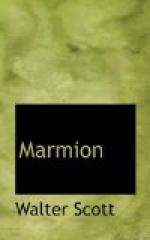Stanza xv. line 287. ’In Scotland there are about twenty palaces, castles, and remains, or sites of such,
“Where SCOTIA’S kings of other years”
had their royal home.
’Linlithgow, distinguished by the combined strength and beauty of its situation, must have been early selected as a royal residence. David, who bought the title of saint by his liberality to the Church, refers several of his charters to his town of Linlithgow; and in that of Holyrood expressly bestows on the new monastery all the skins of the rams, ewes, and lambs, belonging to his castle of Linlitcu, which shall die during the year....The convenience afforded for the sport of falconry, which was so great a favourite during the feudal ages, was probably one cause of the attachment of the ancient Scottish monarchs to Linlithgow and its fine lake. The sport of hunting was also followed with success in the neighbourhood, from which circumstance it probably arises that the ancient arms of the city represent a black greyhound bitch tied to a tree....The situation of Linlithgow Palace is eminently beautiful. It stands on a promontory of some elevation, which advances almost into the midst of the lake. The form is that of a square court, composed of buildings of four storeys high, with towers at the angles. The fronts with the square, and the windows, are highly ornamented, and the size of the rooms, as well as the width and character of the staircases, are upon a magnificent scale. One banquet-room is ninety-four feet long, thirty feet wide, and thirty-three feet high, with a gallery for music. The King’s wardrobe, or dressing-room, looking to the west, projects over the walls, so as to have a delicious prospect on three aides, and is one of the most enviable boudoirs we have ever seen.’—Sir Walter Scott’s Provincial Antiquities.—Prose Works, vol. vii. p. 382.




